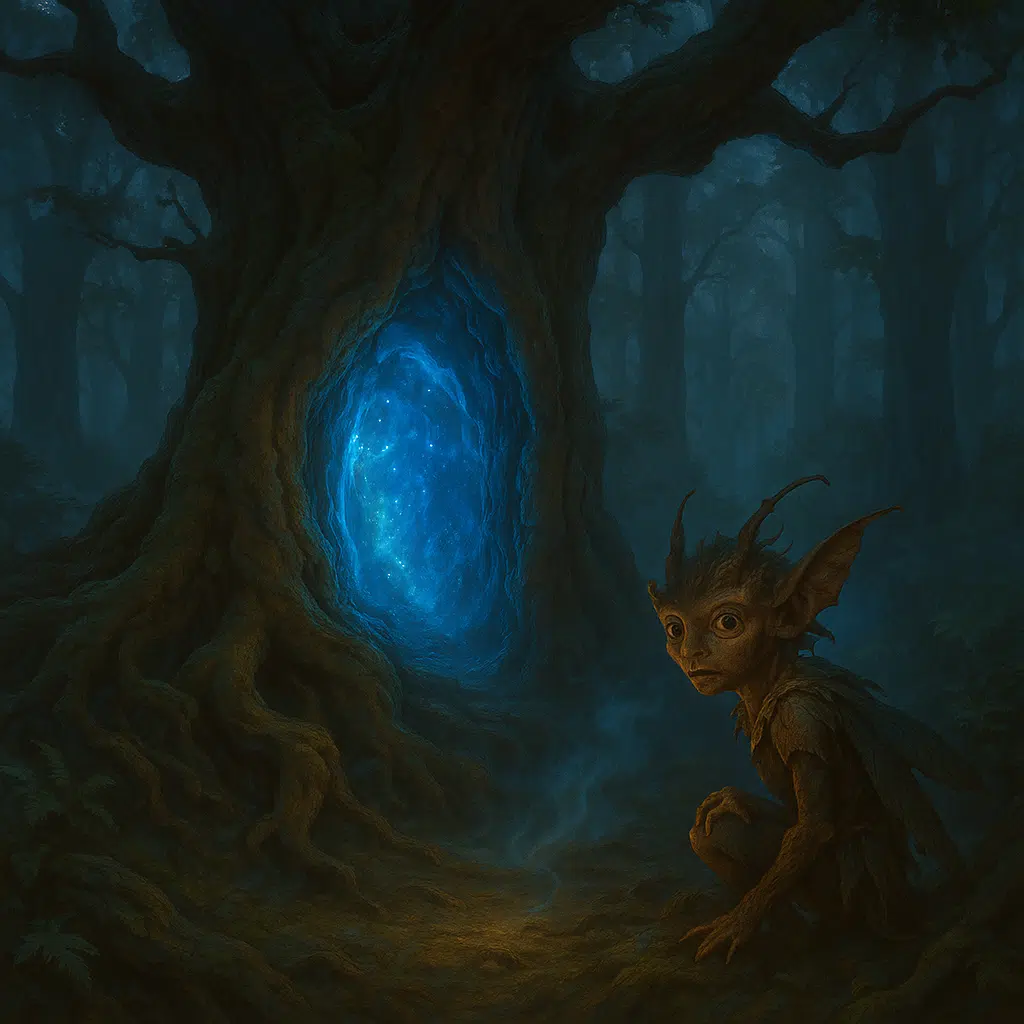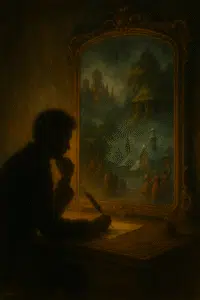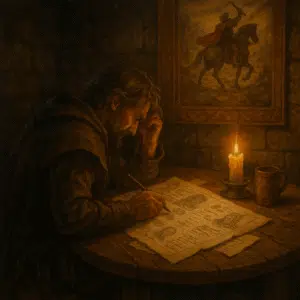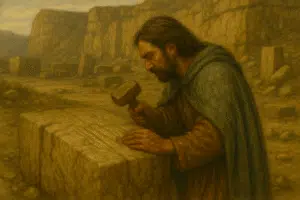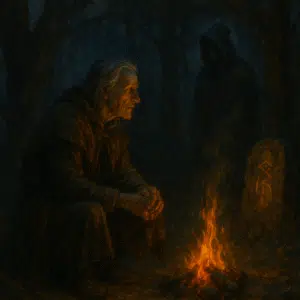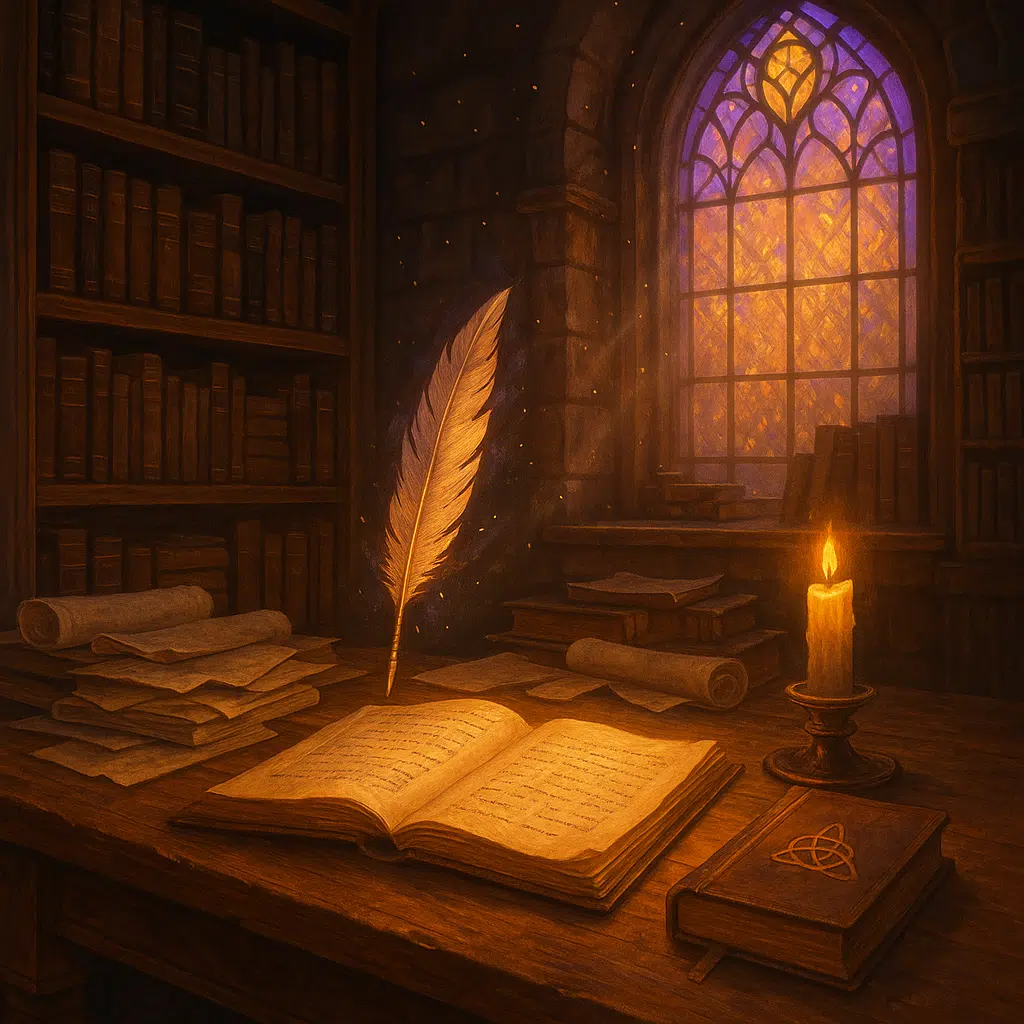Estimated Reading Time: 41 minutes (7724 words)
A dragon soaring over crystal spires in a world that never was stands in stark contrast to the college professor who discovers an ancient spell book hidden in their basement. Both are fantasy, yet they represent fundamentally different approaches to magical storytelling.
High fantasy and low fantasy exist as distinct territories on the same imaginative map. The distinction isn’t about quality or depth, but rather about the relationship between the magical and the mundane—how far the story ventures from our familiar world, and how central supernatural elements are to the narrative’s foundation.
The difference matters because it shapes everything from reader expectations to worldbuilding requirements. When writers understand whether they’re crafting high or low fantasy, they make more cohesive creative choices. When readers recognize these patterns, they can better find stories that resonate with their particular taste for wonder.
The boundaries between these subgenres have blurred in recent decades as authors experiment with hybrid approaches, but the core distinctions remain instructive. The distance between Tolkien’s meticulously constructed Middle-earth and the hidden magical London of Neverwhere reveals how fantasy creates different kinds of enchantment depending on where it positions its magical elements relative to our reality. That sense of placement—how magic intersects with the mundane—is key to Immersion by Design, where subtle sensory choices define how the audience steps into the world.
High fantasy and low fantasy offer distinctly different reading experiences while existing on the same imaginative spectrum. Understanding these subgenres helps readers find stories that match their taste and gives writers clarity about the worlds they’re building. Each style carries unique strengths that shape how magic, wonder, and the familiar interact on the page—a balance that also defines the GM’s role in Where the Rules End, where tonal choice governs how rules serve emotion.
- Check the magic system’s prominence: High fantasy centralizes magic as a fundamental force (think Gandalf’s spells in Middle-earth), while low fantasy treats magic as exceptional within a recognizable world (like the subtle magic in Jonathan Strange & Mr. Norrell).
- Examine the setting’s relationship to our world: High fantasy creates entirely separate worlds with their own geography and history, whereas low fantasy inserts magical elements into our recognizable reality or a close historical analogue.
- Notice the stakes and scope of conflict: High fantasy often features world-altering conflicts against ultimate evil, while low fantasy typically presents more localized threats and personal challenges with regional consequences.
- Consider the protagonist’s journey: Heroes in high fantasy frequently follow epic quests that reshape their universe, while low fantasy protagonists navigate magical disruptions to a more familiar life, often maintaining some semblance of normalcy.
- Assess the worldbuilding depth: High fantasy invests heavily in complex cultures, languages, and mythologies (like Tolkien’s extensive background lore), while low fantasy builds selectively on existing social frameworks, focusing on specific deviations from reality.
- Look for blended approaches in modern fantasy: Contemporary authors increasingly combine elements from both subgenres, creating works that exist in the fertile middle ground between pure high and low fantasy traditions.
Whether you prefer the grand escapism of completely immersive secondary worlds or magic that subtly transforms familiar settings, understanding these distinctions helps navigate the rich landscape of fantasy fiction. Let’s explore how these differences shape the stories we love and the worlds we dream about.
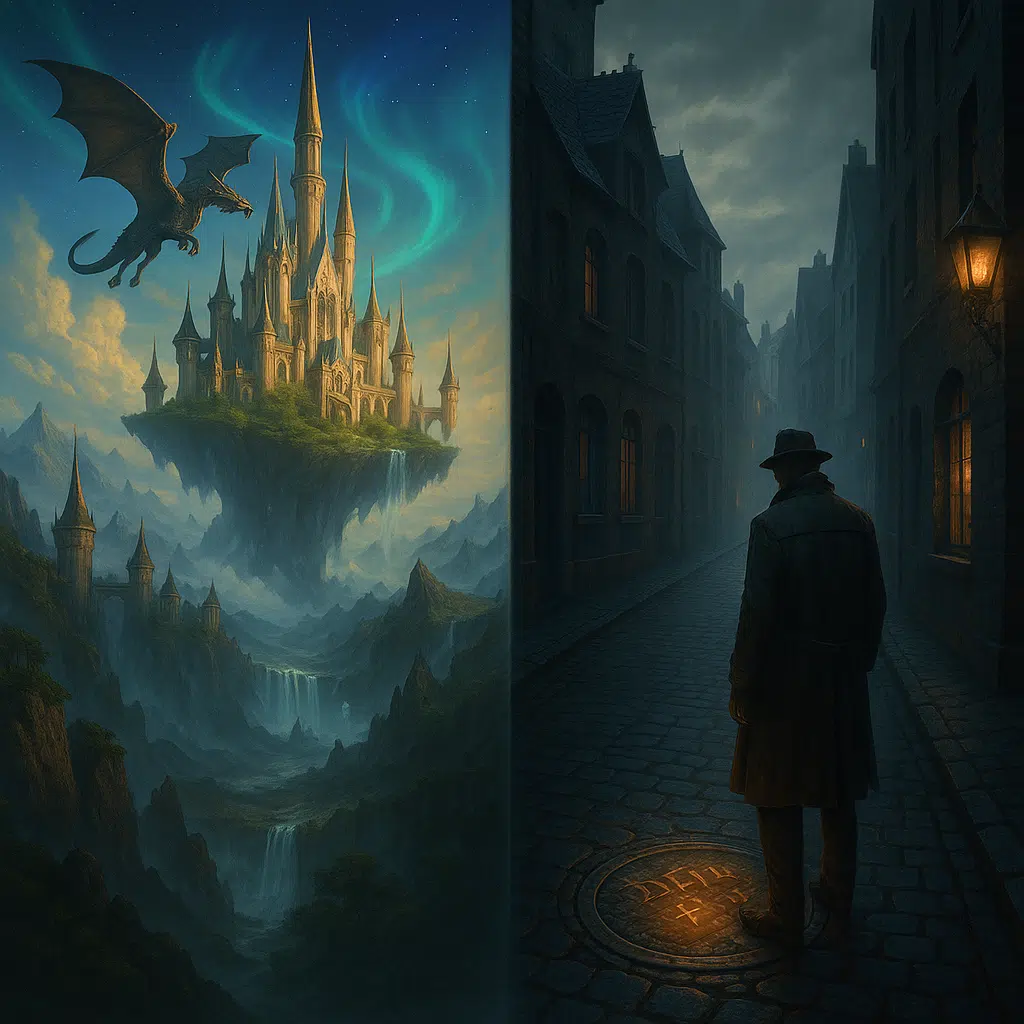
The Magical Spectrum of Fantasy Fiction
The essence of fantasy’s dual traditions
Fantasy fiction occupies a unique position in literature, offering readers entry into worlds where magic exists and impossibility becomes possible. Within this broad genre lie two distinct traditions that approach the fantastic from fundamentally different angles. High fantasy and low fantasy represent complementary visions of how magic might interact with reality, each with its own aesthetic, thematic concerns, and storytelling conventions.
High fantasy embraces the wholly otherworldly—complete magical realms where supernatural forces are woven into the very fabric of existence. This tradition, exemplified by works like J.R.R. Tolkien’s “The Lord of the Rings” or George R.R. Martin’s “A Song of Ice and Fire,” creates elaborate secondary worlds with their own physical laws, histories, and mythologies. The magic in these realms isn’t an aberration but a foundational element of how these worlds function.
Low fantasy, by contrast, keeps its feet planted in the mud. Its stories often unfold in worlds that feel lived-in and morally complex, where the stakes are personal and the victories uncertain. If high fantasy is the ballad of heroes, low fantasy is the journal of survivors. I explore how these grounded stories mirror the emotional logic of real people in Creating Authentic Character Profiles, and how systems of consequence shape roleplay in Session Zero.
These traditions aren’t simply technical categories but represent different philosophical approaches to fantasy itself—exploring either the purely imaginative potential of entirely new worlds or the transformative potential when magic touches our familiar reality.
Why categorization matters to readers and writers
Understanding the distinction between high and low fantasy serves both practical and artistic purposes for those who engage with the genre. For readers, these categories provide useful navigational tools when exploring fantasy fiction, helping set appropriate expectations about the reading experience. A reader seeking complete escapism might gravitate toward high fantasy’s immersive secondary worlds, while someone interested in seeing familiar reality twisted and transformed might prefer the uncanny juxtapositions of low fantasy.
For writers, recognizing these traditions offers clarity about the fundamental creative decisions that shape a fantasy narrative. Whether to construct an entirely new world with its own rules or to insert magical elements into our familiar reality represents one of the earliest and most consequential choices in crafting fantasy fiction. This decision influences everything from worldbuilding depth to character motivation to the nature of conflict within the story.
Publishers and booksellers also benefit from these classifications when marketing works to appropriate audiences. Fantasy readers often develop preferences for particular approaches to the genre, and accurate categorization helps connect books with readers most likely to appreciate them. However, these categories should be understood as points along a spectrum rather than rigid boxes, providing a framework for understanding rather than limiting creative expression.
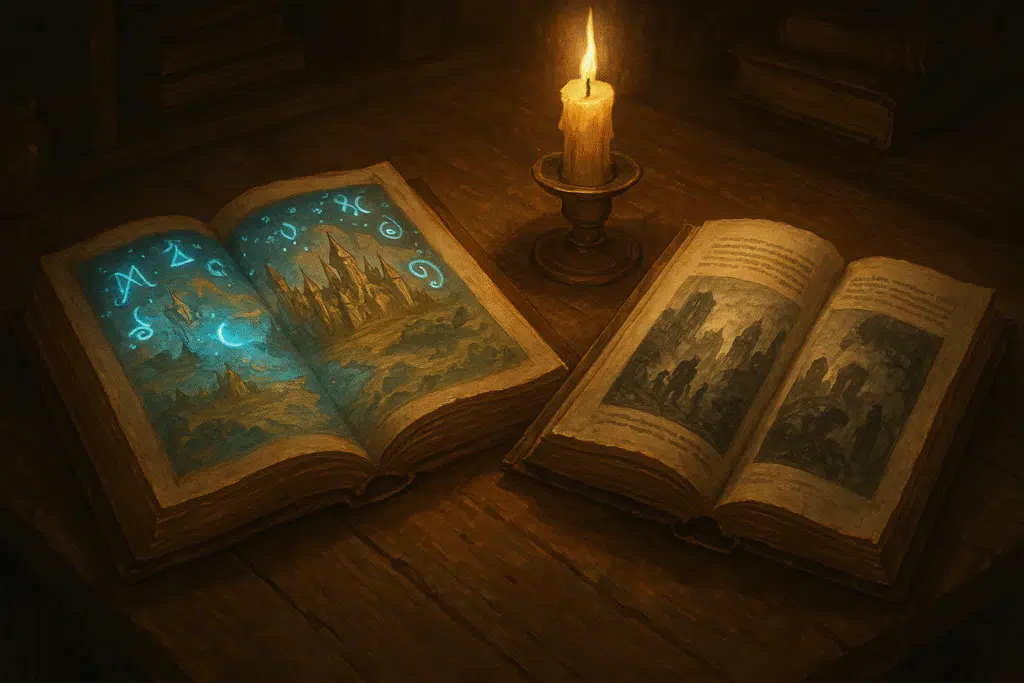
Defining the Two Realms
High fantasy’s complete otherworldliness
High fantasy transports readers to worlds that exist entirely outside our own universe—realms where the rules of reality are fundamentally different. These secondary worlds operate according to their own internal logic and physical laws, often featuring magic as an integral component of their natural order. Whether it’s Middle-earth, Earthsea, Westeros, or countless other fantastical realms, these settings aren’t merely altered versions of our world but complete alternatives with their own cosmologies.
The otherworldliness of high fantasy extends beyond mere geography to encompass distinct histories, cultures, races, languages, and metaphysical frameworks. Tolkien’s concept of “subcreation”—the careful construction of an internally consistent imaginary world—epitomizes the high fantasy approach. These worlds typically possess their own creation myths, ancient histories, and comprehensive magical systems that shape how their societies function. The most ambitious works in this tradition, like Brandon Sanderson’s “The Stormlight Archive” or Robert Jordan’s “The Wheel of Time,” develop entire cosmologies explaining how their worlds came to be and how they continue to operate.
While high fantasy worlds may occasionally mirror or comment on aspects of our reality, they remain fundamentally separate, allowing for explorations of possibilities unbounded by the constraints of actual history or physics. This complete separation creates a sense of wonder and discovery as readers encounter civilizations, creatures, and magical phenomena that could never exist in our world. The resulting sense of escape and alterity forms a central appeal of the high fantasy tradition.
Low fantasy’s magical intrusions into reality
Low fantasy anchors its narratives in a world that largely resembles our own familiar reality, introducing magical or supernatural elements as exceptions to otherwise natural laws. This approach creates narrative tension through the collision between the ordinary and the extraordinary, highlighting the disruptive power of magic when it enters a world not designed to accommodate it.
In works like Stephen King’s “The Dark Tower” series or many urban fantasy novels, magic exists as a hidden dimension or secret knowledge accessible only to a select few. The protagonist often begins firmly rooted in the mundane world before encountering supernatural elements that challenge their understanding of reality. This journey from the familiar to the fantastic forms a common narrative pattern in low fantasy, as characters must reconcile their understanding of how the world works with new evidence of magical forces.
The intrusion of magic into reality creates several powerful storytelling opportunities unique to low fantasy. It allows authors to explore the psychological impact of encountering the impossible, to use the supernatural as metaphor for real-world concerns, and to create dramatic irony through characters’ skepticism about magical phenomena that readers know to be real within the story. Works like Susanna Clarke’s “Jonathan Strange & Mr Norrell” or Helene Wecker’s “The Golem and the Jinni” derive much of their narrative power from the tension between historical reality and magical intrusion.
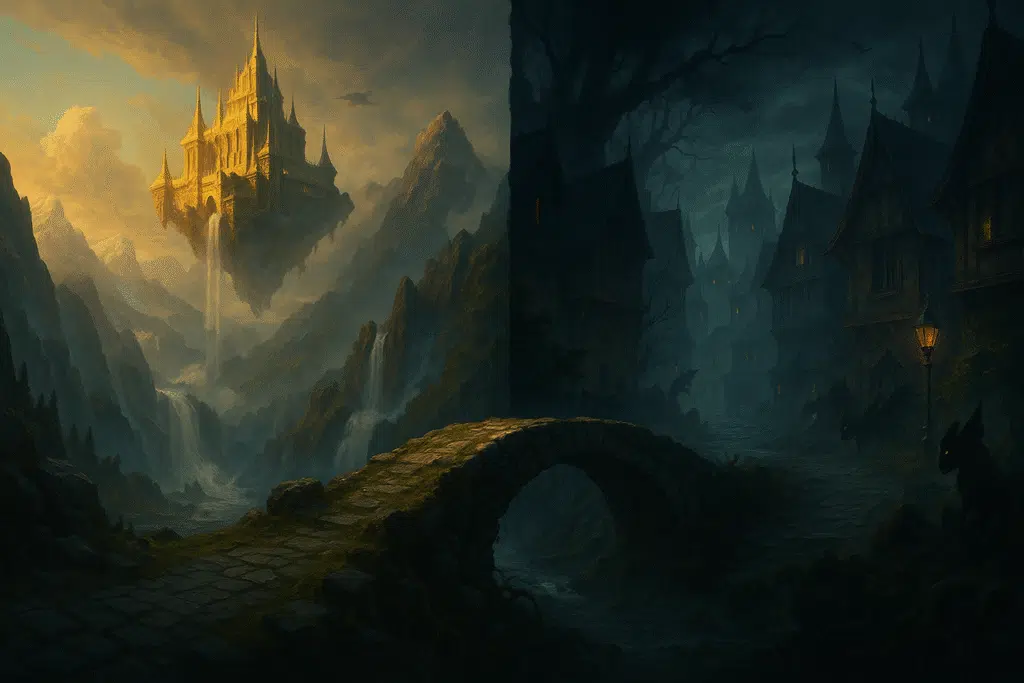
Worlds Apart: The Question of Setting
Secondary worlds with their own physical laws
The secondary worlds of high fantasy represent some of literature’s most ambitious creative endeavors—entirely invented universes with distinctive geographies, ecosystems, and metaphysical frameworks. These settings are more than mere backdrops; they function as characters in their own right, with their unique properties fundamentally shaping the narratives that unfold within them.
In these worlds, the physical laws themselves may differ from those governing our reality. In N.K. Jemisin’s “The Fifth Season,” a planet experiences apocalyptic climate events called “Seasons” that have shaped both its geology and civilization. In Brandon Sanderson’s “Mistborn” series, mysterious mists cover the land each night, and the sky rains ash from constantly active volcanoes. These environmental conditions aren’t simply decorative but integral to how these worlds function and how their inhabitants live.
The most fully realized secondary worlds contain diverse ecosystems, multiple cultures with distinct histories and traditions, and complex geopolitical situations that have evolved organically over time. They often feature non-human races with physiologies and cultures that could not exist in our world, from Tolkien’s elves and dwarves to the vast array of fantastical beings populating modern high fantasy. The freedom to create entirely new species allows authors to explore questions of consciousness, society, and morality from perspectives impossible in strictly realistic fiction.
The disconnection from our reality also permits high fantasy to manipulate time scales beyond human experience. Histories might span thousands or even millions of years, with ancient events continuing to influence contemporary circumstances. This vast temporal canvas allows for the development of complex magical traditions, the rise and fall of multiple civilizations, and the evolution of mythologies that shape characters’ worldviews.
Our world with supernatural exceptions
Low fantasy remains tethered to our familiar reality while introducing selective supernatural elements that create points of departure from established natural laws. This approach grounds fantastical elements in recognizable settings, making the intrusion of magic all the more striking through contrast with the mundane.
These narratives typically unfold in versions of our world either historically accurate or closely resembling it, with magical elements carefully integrated into existing frameworks. Deborah Harkness’s “All Souls Trilogy” places witches, vampires, and demons in contemporary Oxford and other real-world locations, while Erin Morgenstern’s “The Night Circus” sets its magical competition against the backdrop of late 19th and early 20th century Europe and America. The familiarity of these settings allows readers to more immediately grasp the implications when supernatural elements disrupt established reality.
Low fantasy often employs the concept of “hidden worlds”—magical realms existing alongside ordinary reality but concealed from most people. Harry Potter’s Platform 9¾ and Diagon Alley, the shadow societies of urban fantasy, and the parallel dimensions in Philip Pullman’s “His Dark Materials” all exemplify this approach. These hidden worlds create a sense of mystery and possibility within seemingly ordinary settings, suggesting magic might exist just beyond our perception.
The use of real-world settings also enables low fantasy to engage directly with historical events and cultural contexts. Historical fantasy can reframe actual events through supernatural lenses, as in Susanna Clarke’s alternate Napoleonic War with magicians, while contemporary urban fantasy often addresses social issues through fantastical metaphors. This grounding in recognizable reality gives low fantasy a particular power to comment on our world while simultaneously transforming it.
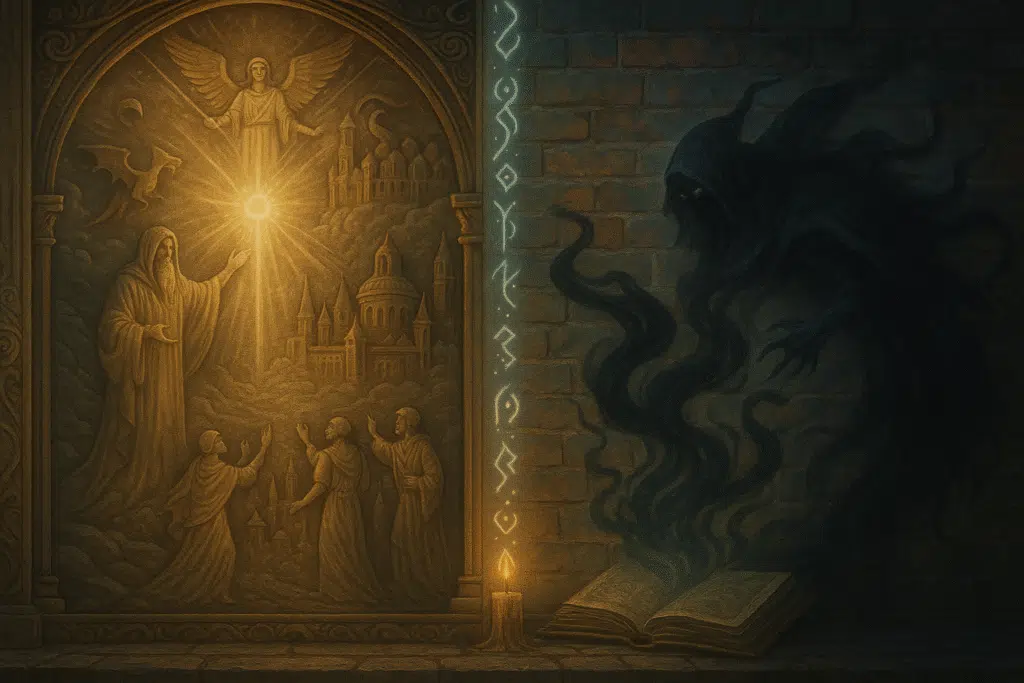
Magic Systems and Their Foundations
When magic shapes civilization and history
In high fantasy, the world often teeters on the brink of collapse. The scale is epic, the consequences vast—kingdoms rise and fall, and the fate of the world hangs in the balance. These stories carry a mythic weight, often entwined with grand moral binaries. Characters aren’t just reacting; they’re part of a larger tapestry woven by fate, prophecy, or divine intervention. If you’re worldbuilding in this genre, consider how setting scale influences narrative stakes—something I break down in How to Build Immersive Fantasy Worlds.
This deep integration manifests in multiple ways across high fantasy worlds. Politically, magical ability often determines social hierarchy, with wizards, sorcerers, or other magic-wielders forming elite classes or advisory councils to rulers. The governance systems themselves might incorporate magical processes, as in L.E. Modesitt Jr.’s “Saga of Recluce” where nations organize around different magical principles. Economic systems similarly reflect magical influence, with magical resources becoming valuable commodities and enchanted items serving both practical and luxury roles.
The very architecture and infrastructure of high fantasy worlds frequently showcase magical engineering. Cities may be constructed with spells rather than mechanical methods, transportation networks might rely on magical portals rather than roads, and defensive structures often incorporate arcane protections alongside physical barriers. In Steven Erikson’s “Malazan Book of the Fallen,” entire cities are carved from single massive bones or built atop floating mountains, demonstrating how magic enables construction impossible by mundane means.
Perhaps most importantly, the presence of magic throughout history shapes cultural development and collective knowledge. Educational systems center around magical instruction, religious beliefs incorporate magical cosmologies, and scientific understanding may blend with arcane principles. The inheritance of magical ability often creates dynastic lineages, while the historical use or misuse of powerful magic generates cultural memory that influences contemporary attitudes. Magic becomes not merely a tool but a lens through which societies understand their world and their place within it.
When magic disrupts the natural order
In low fantasy narratives, magic functions as a disruptive force that challenges established understanding of how the world works. Rather than forming the foundation of civilization, supernatural elements appear as exceptions to natural law—unexplainable phenomena that force characters to question their fundamental assumptions about reality.
This disruptive quality creates narrative tension as characters must reconcile magical occurrences with their existing worldview. In Katherine Arden’s “The Bear and the Nightingale,” set in medieval Russia, the protagonist must navigate between Christian doctrine and ancient magical beings that still inhabit the forests. Jim Butcher’s “Dresden Files” depicts a modern Chicago where the supernatural remains hidden from most people, with the wizard protagonist constantly negotiating the boundary between magical and mundane authorities.
Magic in low fantasy typically appears with unclear boundaries and rule systems, reflecting its position outside established knowledge. While high fantasy might present magic as a well-documented force with consistent principles, low fantasy often portrays it as mysterious, unpredictable, or governed by forgotten rules that must be rediscovered. This approach emphasizes magic’s otherness and reinforces its position as an intrusion rather than a foundation.
The disruptive nature of magic in these settings creates consequences for those who encounter it. Characters may suffer social isolation when they experience supernatural events others cannot verify, face psychological challenges integrating magical realities with their prior understanding of the world, or experience physical dangers from forces they don’t fully comprehend. This focus on personal consequences of magical disruption gives low fantasy a psychological dimension that complements its supernatural elements.
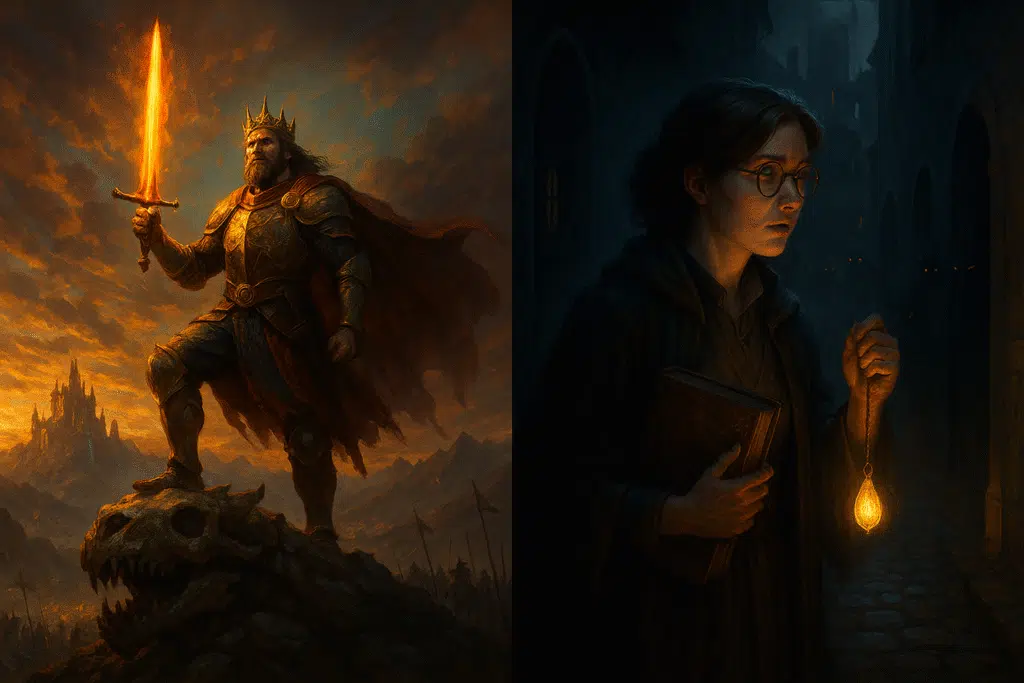
The Hero’s Journey Reimagined
Destined champions of mythic proportions
High fantasy frequently centers on protagonists whose destinies mark them for extraordinary roles within their worlds. These characters often embody archetypal qualities—the lost heir, the chosen one, the prophesied savior—that place them at the center of world-changing events. Their personal journeys parallel the larger mythic structures of their worlds, connecting individual character development with cosmic significance.
The concept of destiny plays a crucial role in shaping these protagonists’ arcs. Characters like Rand al’Thor in “The Wheel of Time” or Paul Atreides in “Dune” (which, while technically science fiction, employs many high fantasy tropes) discover they fulfill ancient prophecies that both empower and constrain them. This tension between predetermined fate and personal choice forms a central conflict, as protagonists struggle to maintain their humanity while fulfilling mythic roles. The weight of destiny creates internal pressure that complements external conflicts, forcing characters to confront questions of free will and personal responsibility.
High fantasy protagonists typically undergo transformative journeys that elevate them far beyond ordinary capabilities. They may discover latent magical abilities, master ancient weapons, connect with powerful entities, or unlock forgotten knowledge that fundamentally changes their relationship with their world. Eragon in Christopher Paolini’s “Inheritance Cycle” begins as a farm boy but develops into a Dragon Rider with magical abilities and political influence that reshape his entire continent. These transformations serve both narrative purposes, providing power escalation that matches rising stakes, and thematic ones, exploring how extraordinary abilities affect human perspective and moral reasoning.
Though mythically proportioned, the most compelling high fantasy protagonists retain human complexity that prevents them from becoming mere symbols. Their struggles with doubt, temptation, and the burden of responsibility create psychological depth that grounds their supernatural journeys in recognizable emotional territory. The best works in this tradition use their protagonists’ extraordinary circumstances to illuminate universal aspects of human experience, making mythic journeys resonate with readers’ own lives despite their fantastical contexts.
Ordinary people facing extraordinary circumstances
Low fantasy typically centers on protagonists who begin as ordinary individuals without special destinies or inherent powers before encountering supernatural elements that transform their lives. These characters represent the reader’s perspective as they discover magical realities alongside the audience, their everyday backgrounds making their extraordinary experiences more immediately relatable.
Since these protagonists lack predestined roles, their heroism emerges from choice rather than prophecy. When confronted with supernatural threats or opportunities, they must decide whether to engage with forces beyond their understanding or return to the safety of familiar reality. In Charlaine Harris’s “Southern Vampire Mysteries,” Sookie Stackhouse’s telepathic ability makes her aware of a hidden vampire society, but her continued involvement stems from personal decisions rather than cosmic necessity. This emphasis on choice creates distinctive moral dynamics as characters take responsibility for entering magical situations without the justification of destiny.
The growth trajectory for low fantasy protagonists typically involves adaptation rather than transformation. Rather than developing mythic powers themselves, they learn to navigate between mundane and magical realities, developing specialized knowledge or skills that allow them to function in both worlds. Harry Dresden in Jim Butcher’s series remains fundamentally human despite his wizard abilities, confronting supernatural threats with a mixture of magical knowledge, detective skills, and street smarts. This model of pragmatic adaptation encourages readers to recognize capabilities within themselves rather than aspiring to superhuman transformation.
The everyday qualities of low fantasy protagonists create opportunities for exploring psychological realism within fantastical contexts. These characters often struggle with balancing their awareness of supernatural elements against maintaining normal lives, relationships, and responsibilities. This tension between ordinary and extraordinary demands generates relatable conflicts even within highly fantastical scenarios, keeping the human consequences of magical events at the narrative center.
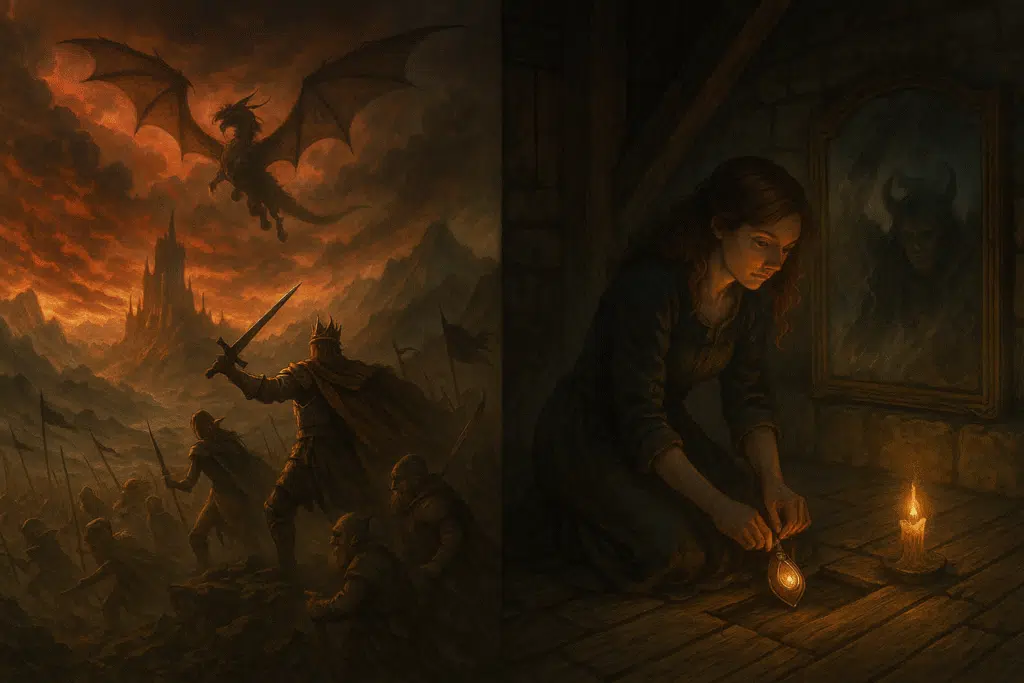
Epic vs. Intimate: The Scale of Conflict
World-ending threats and cosmic battles
High fantasy characteristically features conflicts of immense scale, with stakes that encompass the fate of entire worlds, civilizations, or cosmic orders. These grand-scale threats provide the necessary magnitude to match the otherworldly settings and mythic protagonists that define the subgenre, creating narratives where personal journeys intersect with historical pivots.
The antagonistic forces in high fantasy often manifest as existential threats to entire civilizations. Dark lords like Sauron in “The Lord of the Rings,” ancient evils awakening after centuries of dormancy, or invading armies with world-conquering ambitions create conflicts where failure means not just personal defeat but collective catastrophe. The scope of these threats necessitates responses of similar scale, typically involving alliances across nations, races, or magical traditions to counter forces no single entity could oppose.
The battlefields where these conflicts play out match their epic stakes, featuring massive armies clashing across mythic landscapes, magical duels that reshape geography, or spiritual confrontations that determine the metaphysical balance of entire worlds. David Gemmell’s “Legend” depicts the siege of a massive fortress as both military engagement and symbolic last stand, while N.K. Jemisin’s “The Broken Earth” trilogy features geological warfare that tears continents apart. These spectacular settings elevate the physical manifestation of conflict to match its thematic significance.
Behind these physical confrontations, high fantasy conflicts often involve philosophical or spiritual dimensions that transcend immediate circumstances. Battles between order and chaos, creation and destruction, or freedom and domination add metaphysical depth to material struggles. In works like Ursula K. Le Guin’s “Earthsea” series, maintaining the fundamental balance of the world becomes as important as defeating specific antagonists. This layering of physical and metaphysical conflict creates narratives where external battles reflect internal or spiritual struggles, connecting spectacular set pieces to meaningful thematic explorations.
Personal struggles with wider implications
Low fantasy typically presents conflicts with more limited immediate scope but significant personal consequences for those involved. Rather than world-ending threats, these narratives often feature antagonistic forces that target individuals, communities, or localized areas, creating stakes that feel immediate and concrete despite smaller scale.
The personal nature of low fantasy conflicts creates psychological intensity that compensates for reduced cosmic significance. When Charles de Lint’s urban fantasy characters confront supernatural threats in their neighborhoods, or when the protagonists of Sarah J. Maas’s “A Court of Thorns and Roses” navigate dangerous fairy courts, the immediacy of danger creates tension despite affecting relatively few people. The protagonist’s close connection to threatened elements—their loved ones, homes, or personal safety—generates emotional investment that makes localized conflicts feel consequential.
While maintaining personal focus, low fantasy conflicts often carry broader implications beyond their immediate circumstances. A supernatural threat to a specific community might represent the first manifestation of a spreading problem, or a personal magical challenge might reveal wider patterns affecting society more subtly. Neil Gaiman’s “American Gods” begins with one man’s unusual employment opportunity but expands to address fundamental questions about belief and cultural identity in America, demonstrating how personal stories can illuminate larger cultural conditions.
This layering of personal and broader significance creates narrative flexibility unique to low fantasy. Authors can shift between intimate character moments and wider implications without requiring apocalyptic threats, allowing for stories that feel both personally meaningful and socially relevant. The supernatural elements provide metaphorical frameworks for exploring real-world issues while keeping narratives grounded in individual experience. This balance makes low fantasy particularly effective for social commentary, as magical elements can highlight patterns or problems in familiar reality while maintaining direct emotional connection through personal stakes.
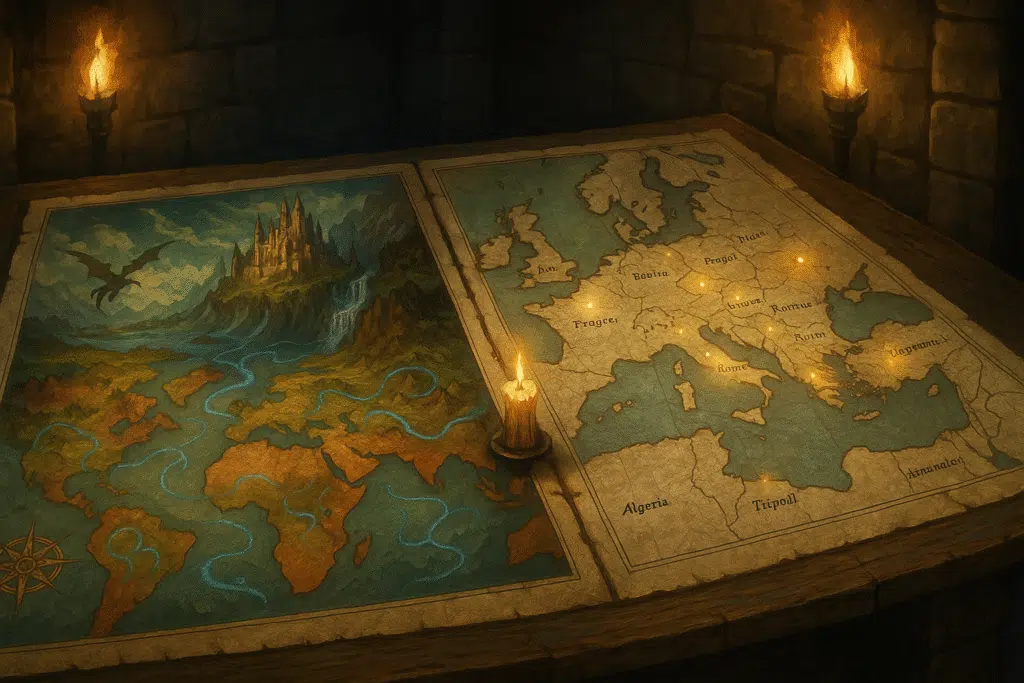
Worldbuilding Approaches Compared
Creating comprehensive alternate realities
High fantasy worldbuilding represents one of fiction’s most comprehensive creative endeavors, requiring authors to construct entire realities with consistent internal logic. This process extends far beyond creating interesting settings to encompass the development of integrated physical, cultural, and metaphysical systems that collectively generate a coherent alternate reality.
The foundational level of high fantasy worldbuilding establishes the physical parameters of the setting—its geography, climate, ecosystems, and natural laws. These elements must be sufficiently detailed to support the narrative while remaining internally consistent. In Steven Erikson’s “Malazan Book of the Fallen,” multiple continents with distinct environments support diverse civilizations, while magical “warrens” provide additional dimensional spaces with their own physical properties. This layered physical reality creates both concrete settings for action and metaphysical frameworks that support the magic system.
Cultural development forms the second major component of high fantasy worldbuilding. Authors must create multiple societies with distinctive histories, traditions, social structures, and value systems that have evolved organically within their physical settings. These cultures require internal diversity and historical depth to feel authentic rather than monolithic. J.R.R. Tolkien’s development of different cultural traditions among elves, humans, dwarves, and hobbits exemplifies this approach, with each group possessing distinct languages, artistic traditions, and historical trajectories that influence their contemporary perspectives.
The metaphysical dimension of high fantasy worldbuilding addresses fundamental questions about how reality functions within the created world. This includes developing cosmologies explaining how the world came into being, religious or philosophical systems interpreting existence, and magic systems integrated with the world’s physical laws. Brandon Sanderson’s detailed magic systems, governed by specific rules with consistent applications and limitations, demonstrate how metaphysical frameworks can provide both narrative opportunities and constraints that drive story development.
The most successful high fantasy worldbuilding achieves a sense of depth where presented elements suggest much more beneath the surface. Like icebergs, these worlds imply vast histories, cultural complexities, and metaphysical depths beyond what appears directly in the narrative, creating the impression of a complete reality that exists independently of the particular story being told within it.
Selectively transforming familiar frameworks
Low fantasy worldbuilding employs a fundamentally different approach, starting with recognizable reality as a foundation before selectively introducing supernatural elements that transform this familiar framework in specific ways. This selective transformation creates uncanny effects by maintaining substantial connection to our world while strategically departing from it in areas that drive the narrative.
The starting point for low fantasy worldbuilding typically involves establishing a version of our reality with historical or contemporary accuracy. This might mean meticulously researching a historical period, as Susanna Clarke did for Napoleonic England in “Jonathan Strange & Mr Norrell,” or carefully rendering a contemporary setting with authentic social dynamics, as in V.E. Schwab’s “Shades of Magic” series. This grounding in recognizable reality provides context that makes magical intrusions more striking and meaningful.
The introduction of supernatural elements follows a selective pattern that maintains overall worldbuilding coherence while creating space for the fantastic. Authors must determine which aspects of reality remain unchanged, which are slightly modified, and which are fundamentally transformed by magical presence. In Jim Butcher’s “Dresden Files,” ordinary Chicago exists alongside a hidden magical community with its own political structures and supernatural beings, while basic physical laws remain mostly intact outside specifically magical contexts. This selective approach creates narrative flexibility while preserving the contrast between mundane and magical that drives low fantasy.
The boundary between ordinary and supernatural realms offers particularly rich worldbuilding territory in low fantasy. Authors develop mechanisms explaining why magical elements remain hidden from general awareness despite their presence—whether through literal concealment spells, psychological blind spots preventing people from processing the supernatural, or social systems maintaining secrecy. These boundary mechanisms create tension between realms that drives many low fantasy narratives, as characters navigate the thresholds between mundane and magical worlds.
Unlike high fantasy’s comprehensive approach, successful low fantasy worldbuilding often employs strategic ambiguity that preserves mystery around supernatural elements. By leaving aspects of magical systems unexplained or only partially revealed, authors maintain the sense of otherness that makes magic feel genuinely magical rather than simply an alternative technology. This calculated incompleteness preserves the disruptive potential of supernatural elements while creating space for reader imagination.
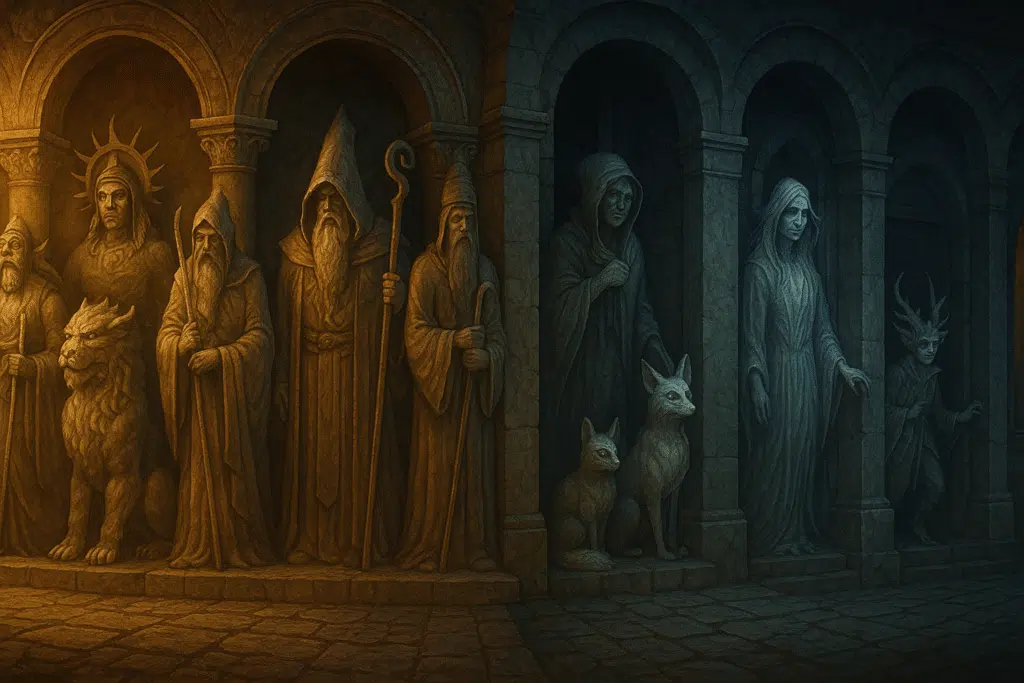
Cultural Resonance in Fantasy Landscapes
Manufacturing entire mythologies and histories
High fantasy authors engage in cultural construction comparable to the work of anthropologists studying real-world civilizations—but with the author creating rather than documenting the material. This process involves developing comprehensive mythological systems, historical narratives, and cultural traditions that provide depth and authenticity to imagined worlds.
The mythological foundations of high fantasy worlds typically include creation stories explaining how the world came into being, legends about the origins of different races or magical forces, and cosmological frameworks describing how supernatural powers interact with the physical realm. J.R.R. Tolkien’s “Silmarillion” represents perhaps the most ambitious example, providing a complete mythological prehistory for Middle-earth from its creation through various ages before the events of “The Lord of the Rings.” These mythological elements establish metaphysical patterns that continue to shape contemporary events within the narrative while providing cultural touchstones for characters.
Historical development in high fantasy extends beyond mythology into documented or remembered history that shapes current political conditions and cultural attitudes. Authors create historical timelines spanning centuries or millennia, including pivotal events like wars, migrations, technological discoveries, and magical catastrophes that collectively explain how the current world state emerged. George R.R. Martin’s extensive backstory for Westeros, including the Targaryen conquest, the Doom of Valyria, and numerous smaller conflicts, provides historical context that makes contemporary political maneuvering more comprehensible and meaningful.
Cultural expressions complete these manufactured landscapes through development of artistic traditions, religious practices, educational systems, and technological approaches specific to different societies within the fantasy world. These expressions manifest in tangible details like architectural styles, clothing patterns, musical forms, and culinary traditions that make abstract cultural concepts concrete within the narrative. When characters in N.K. Jemisin’s “The Fifth Season” employ specific hand gestures as communication forms during environmental catastrophes, these practices reflect deeper cultural adaptations to their unstable world.
The most effective high fantasy worldbuilding integrates these mythological, historical, and cultural elements into coherent systems where each component influences and reflects the others. Religious practices connect to creation myths, artistic traditions reflect historical experiences, and technological approaches respond to environmental conditions. This integration creates the sense of organic cultural development that distinguishes thoughtfully constructed fantasy worlds from mere collections of interesting ideas.
Drawing from recognizable cultural traditions
Low fantasy typically grounds its worldbuilding in recognizable cultural frameworks before introducing supernatural elements that transform or recontextualize these familiar traditions. Rather than manufacturing entirely new cultures, these narratives often draw from existing historical periods, folklore traditions, or contemporary cultural settings, creating resonance through the adaptation of familiar material.
Historical fantasy represents a prominent approach within this tradition, setting narratives within carefully researched historical periods before introducing magical elements. Naomi Novik’s “Temeraire” series places dragons within the Napoleonic Wars, maintaining historical accuracy in military strategies, social structures, and international politics while exploring how the presence of dragons might have transformed these elements. This approach creates immediate cultural depth by drawing on existing historical knowledge while offering fresh perspective through fantastical additions.
Folklore integration provides another common framework for low fantasy worldbuilding, incorporating supernatural beings and magical systems from specific cultural traditions into contemporary or historical settings. Katherine Arden’s “Winternight Trilogy” draws extensively from Russian folklore figures like domovoi (house spirits) and the witch Baba Yaga, placing them within historically accurate medieval Russian society. This approach connects narratives to established mythological traditions while allowing authors to adapt these elements for specific storytelling purposes.
Contemporary urban fantasy typically situates supernatural elements within recognizable modern cultural contexts, using existing social structures, technological frameworks, and cultural references as foundations for worldbuilding. Writers like Ben Aaronovitch in his “Rivers of London” series present magical systems operating within modern police procedures and bureaucracies, creating worldbuilding that explores how traditional institutions might adapt to supernatural realities. This approach offers commentary on contemporary society while making fantastical elements more immediately accessible through familiar contexts.
When drawing from recognizable traditions, successful low fantasy balances authenticity with creative adaptation. Authors must research cultural material thoroughly enough to represent it accurately and respectfully, while still exercising creative freedom to transform these elements in ways that serve their narratives. This balance allows low fantasy to benefit from the depth of existing cultural traditions while offering fresh perspectives that revitalize familiar material through fantastical reframing.
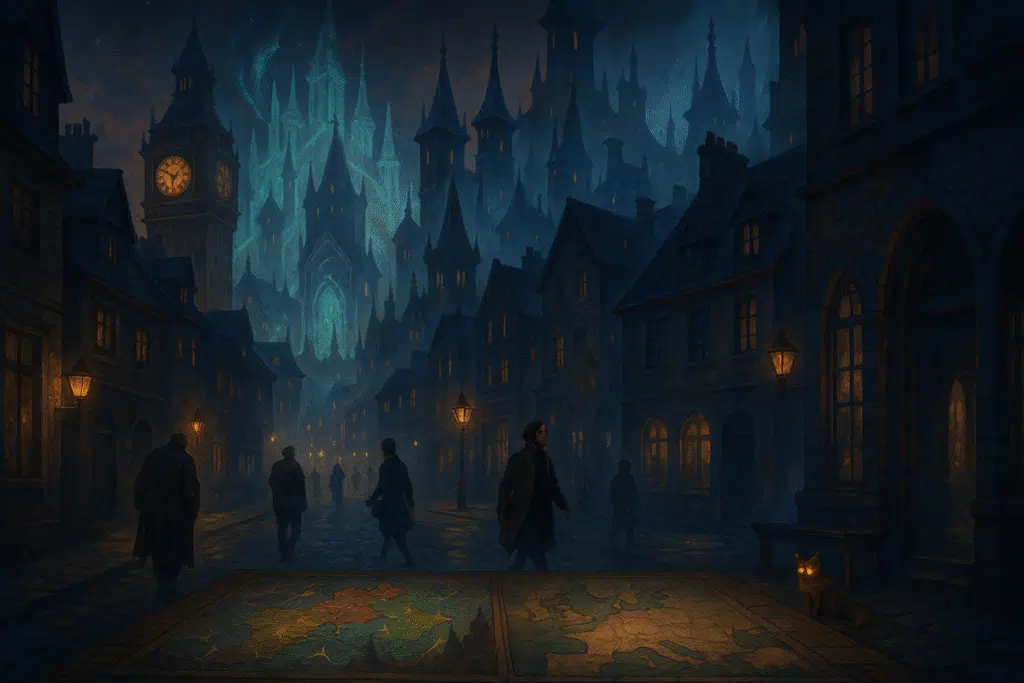
Blended Boundaries in Modern Fantasy
Contemporary works defying simple categorization
Modern fantasy increasingly resists clean categorization along the high/low fantasy spectrum, with many influential works deliberately blending elements from both traditions to create hybrid forms that access the strengths of each approach. These boundary-crossing narratives represent not failed categorization but intentional synthesis that expands the genre’s expressive possibilities.
Some works establish dual settings that incorporate both wholly secondary worlds and recognizable reality. Philip Pullman’s “His Dark Materials” trilogy moves between a modified version of our world and entirely separate realms with different physical laws, while N.K. Jemisin’s “The City We Became” transforms New York City into both itself and something metaphysically different. These multi-dimensional approaches allow narratives to explore both the comprehensive worldbuilding of high fantasy and the disruptive juxtapositions of low fantasy within a single work.
Other narratives maintain single settings that combine elements from both traditions. V.E. Schwab’s “Shades of Magic” series features multiple parallel Londons with varying levels of magic, some closely resembling historical reality and others transformed into almost unrecognizable magical societies. China Miéville’s “Bas-Lag” novels present a secondary world with its own physical laws and magical systems but incorporate industrial technologies, urban environments, and social structures that echo real-world developments. These blended settings allow authors to adjust the balance between familiarity and otherness according to specific narrative needs.
Character development in these hybrid works often combines the mythic proportions of high fantasy protagonists with the psychological realism of low fantasy characters. In Robert Jackson Bennett’s “Divine Cities” trilogy, characters possess extraordinary abilities and confront world-changing conflicts while experiencing the psychological and social challenges of operating within recognizable bureaucratic and political systems. This approach creates protagonists who feel simultaneously larger-than-life and authentically human, connecting mythic significance with relatable experience.
The prevalence of genre-blending works suggests that contemporary fantasy increasingly values flexibility over adherence to traditional categorizations. Rather than viewing high and low fantasy as separate traditions requiring different approaches, many writers treat them as complementary tools available for addressing particular narrative needs. This pragmatic approach focuses on storytelling effectiveness rather than categorical purity, allowing fantasy to develop new forms that respond to evolving reader expectations and cultural contexts.
The fertile middle ground between traditions
Between clearly defined high and low fantasy lies a fertile middle ground where elements from both traditions interact in particularly productive ways. This intermediate space has generated some of contemporary fantasy’s most innovative and influential works by leveraging the creative tension between wholly imagined worlds and transformed reality.
Portal fantasies represent perhaps the most established approach to occupying this middle space, explicitly connecting our world with secondary realms through various transportation mechanisms. C.S. Lewis’s “Chronicles of Narnia” and Lev Grossman’s “The Magicians” both feature characters moving between contemporary reality and magical worlds with different physical laws and historical trajectories. This framework allows narratives to explore both the comprehensive worldbuilding of secondary realms and the psychological impact of encountering magic from a realistic perspective, creating natural comparison points between mundane and magical experiences.
Historical settings with extensive magical transformations offer another approach to the middle ground. Guy Gavriel Kay’s novels typically present worlds clearly modeled on specific historical periods and cultures—Byzantine Empire, Renaissance Italy, Tang Dynasty China—but with altered geography, added fantastic elements, and modified historical developments. This approach maintains connection to recognizable human experience while providing creative freedom to explore alternative possibilities beyond strict historical constraints.
The middle ground also accommodates works featuring highly mechanistic or systematized magic that functions almost like alternative science. Brandon Sanderson’s “Mistborn” series presents a secondary world with comprehensive worldbuilding but grounds its magic in specific physical principles with consistent applications and limitations. This approach combines high fantasy’s complete world creation with low fantasy’s interest in how supernatural elements might function as comprehensible systems within otherwise realistic frameworks.
What unites these diverse approaches is their refusal to choose between complete otherworldliness and magical intrusion, instead finding narrative power in the interaction between these possibilities. The middle ground creates space for works that use juxtaposition itself as a creative strategy, establishing multiple reference points that collectively generate richer meaning than either approach alone might produce. As fantasy continues evolving, this intermediate space likely represents the genre’s most productive territory for innovation, allowing creators to selectively employ elements from both traditions according to specific artistic purposes.
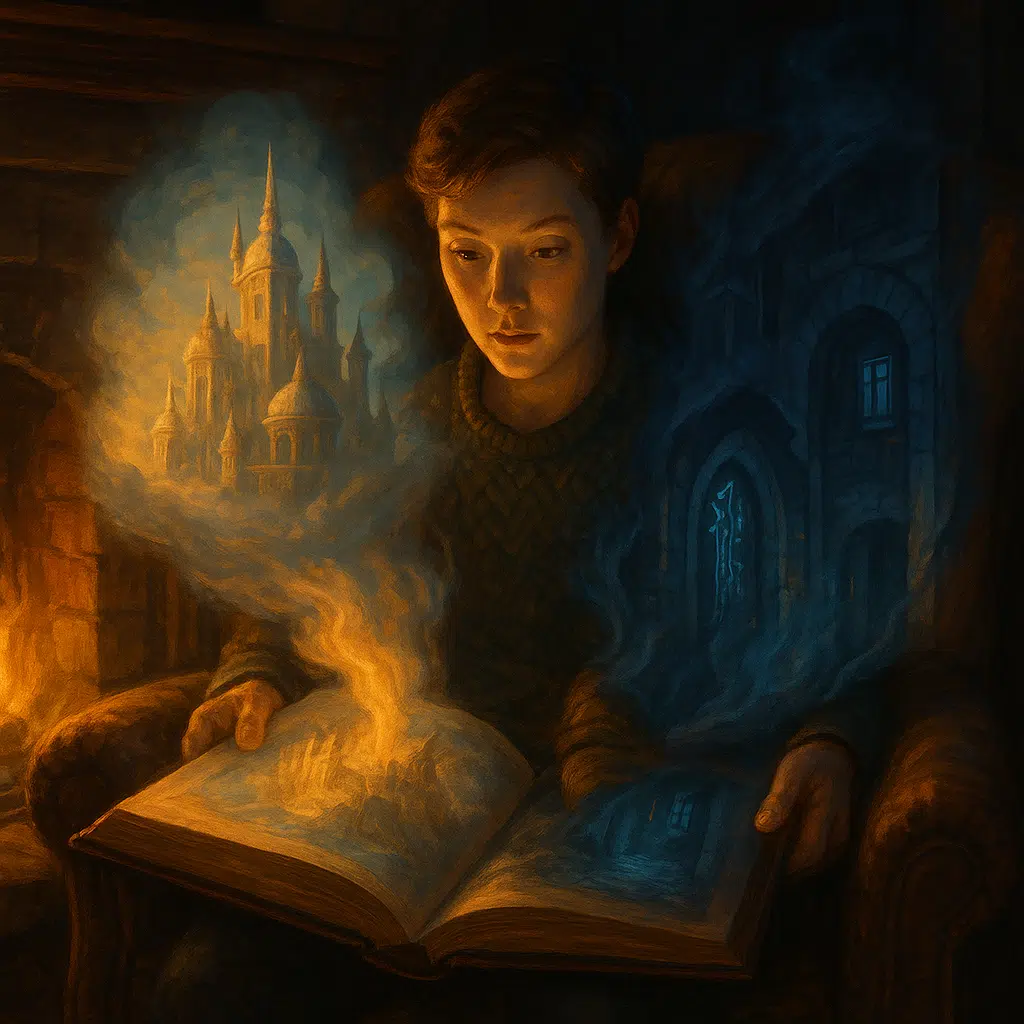
Reader Experience Across the Spectrum
The immersive escape of high fantasy
High fantasy offers readers a distinctive form of literary immersion—complete transportation into worlds operating by different rules than our own. This immersive quality creates reading experiences characterized by discovery, wonder, and temporary escape from familiar reality into coherent alternative possibilities.
The comprehensive worldbuilding typical of high fantasy facilitates deep immersion by providing complete alternative frameworks rather than partial modifications of reality. Readers can fully inhabit these secondary worlds without constant reference to our own, experiencing them as internally consistent environments with their own logic and patterns. This comprehensive quality allows for sustained engagement with the imagined world, as readers progressively discover its geographical features, cultural traditions, and metaphysical systems through narrative exploration.
The sense of discovery represents a central pleasure in high fantasy reading experiences. As authors gradually reveal the scope and complexity of their created worlds, readers experience the satisfaction of expanding understanding comparable to learning about an unfamiliar culture or historical period. This progressive revelation creates momentum beyond plot development, with worldbuilding itself providing intellectual and imaginative rewards. The most successful high fantasy works carefully balance revelation and mystery, providing sufficient information to orient readers while maintaining unexplored territories that sustain curiosity.
The distance between high fantasy settings and ordinary reality creates space for readers to engage with challenging themes through metaphorical frameworks. Moral questions, political conflicts, and philosophical issues can be explored outside their real-world contexts, allowing fresh perspective unburdened by immediate associations. Ursula K. Le Guin’s examination of gender through the androgynous society of “The Left Hand of Darkness” demonstrates how secondary worlds can provide conceptual distance that illuminates familiar issues from new angles. This metaphorical distance creates both intellectual freedom and emotional safety for exploring difficult subjects.
While sometimes criticized as mere escapism, the immersive quality of high fantasy ultimately offers a form of perspective-shifting that can influence how readers understand their own reality. By temporarily inhabiting worlds with different foundational assumptions, readers may recognize which aspects of their own experience represent contingent cultural constructions rather than inevitable realities. This perspective-shifting represents not an escape from reality but a detour that potentially leads to deeper understanding of our world through contrast with imagined alternatives.
The uncanny familiarity of low fantasy
Low fantasy generates a distinctly different reading experience centered on the uncanny—the simultaneously familiar and strange. By introducing supernatural elements into recognizable settings, these narratives create cognitive dissonance that prompts readers to reconsider their assumptions about ordinary reality and its possibilities.
The juxtaposition of magical elements with familiar frameworks produces what Freud termed “the uncanny”—the unsettling effect when the ordinary becomes strange or the impossible appears within everyday contexts. When Neil Gaiman reveals a magical London Below existing beneath the familiar city in “Neverwhere,” or when Erin Morgenstern’s impossible night circus appears in Victorian-era fields, readers experience the destabilizing thrill of seeing familiar reality transformed. This uncanny quality creates distinctive emotional responses ranging from wonder to terror as comfortable assumptions about reality dissolve.
Identification with protagonists forms another key component of the low fantasy reading experience. Since most low fantasy features characters initially unfamiliar with supernatural elements, readers discover magical realities alongside these viewpoint characters, sharing their progressive movement from disbelief through acceptance to engagement. This parallel journey creates strong reader identification and makes even highly fantastical developments feel accessible through characters’ relatable reactions. The gradual expansion of possibility through character experience mirrors the readers’ own expanding imaginations as they accommodate increasingly magical elements.
The proximity to recognizable reality allows low fantasy to comment directly on contemporary concerns through fantastical metaphors. Urban fantasy often addresses social issues like discrimination, economic inequality, or technological change through supernatural frameworks that illuminate real conditions while providing emotional distance. Mike Carey’s “Felix Castor” series explores gentrification in London through the metaphor of the rising dead, while Charlaine Harris examines prejudice through vampire “coming out of the coffin” in her “Southern Vampire Mysteries.” This metaphorical approach allows readers to engage with social commentary through frameworks that balance familiarity with transformative perspective.
The most distinctive aspect of low fantasy’s reading experience may be its suggestion that magic could exist within our own reality if we knew where to look. By presenting supernatural elements as hidden dimensions of otherwise familiar worlds, these narratives invite readers to maintain a sense of possibility beyond rational certainty. This invitation to wonder can extend beyond the reading experience into everyday life, encouraging attentiveness to the potentially extraordinary within ordinary experience.
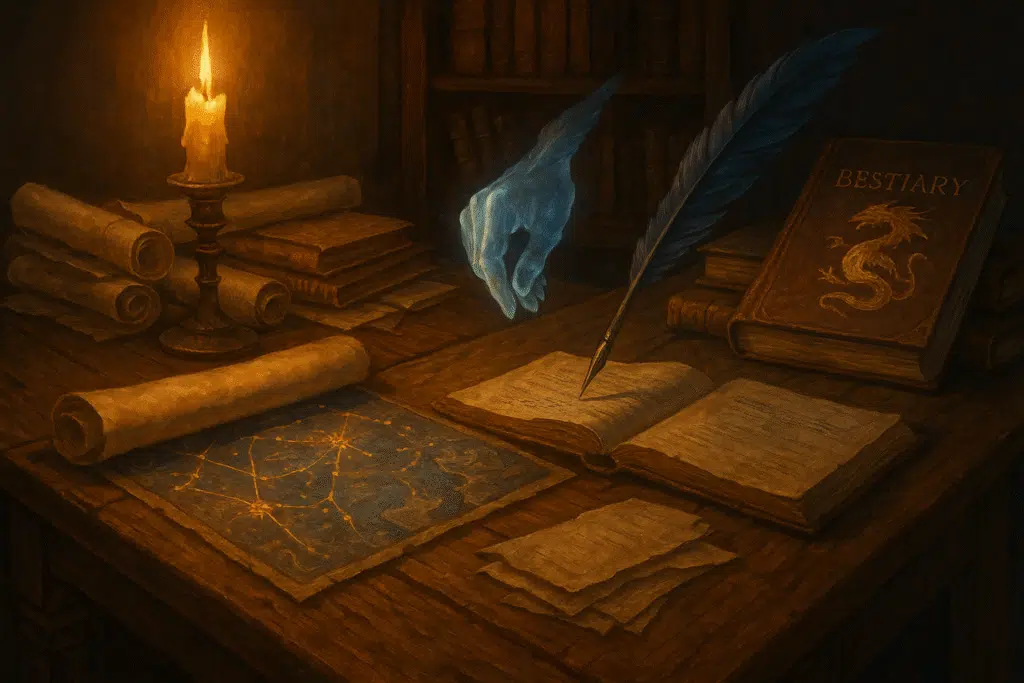
Crafting Within the Traditions
Writing challenges specific to each approach
Writers working in high and low fantasy face distinctive creative challenges stemming from the fundamental structures of these traditions. Understanding these challenges helps both writers and readers appreciate the specific craft requirements of different fantasy approaches.
High fantasy presents particular worldbuilding demands that can overwhelm narrative momentum if not carefully managed. The need to create comprehensive secondary worlds requires extensive development work, but presenting this material without disrupting story flow creates significant craft challenges. Writers must balance exposition with narrative progression, finding organic ways to introduce necessary worldbuilding without resorting to information dumps that halt dramatic movement. Techniques like revealing world elements through character experience, distributing information across multiple viewpoints, and allowing some details to remain implied rather than explicit help maintain this balance between worldbuilding depth and narrative drive.
Maintaining internal consistency presents another major challenge in high fantasy writing. As secondary worlds grow more complex, tracking the implications of established elements becomes increasingly difficult. A magical system introduced early in a series creates constraints that limit later narrative possibilities, while political decisions by characters should generate logical consequences within established cultural frameworks. This need for consistency requires meticulous record-keeping and careful planning to avoid contradictions that undermine the world’s credibility. Some authors develop extensive “bibles” documenting their worlds’ rules, while others employ continuity editors to maintain consistency across long series.
Low fantasy writers face different challenges, particularly in establishing credible boundaries between magical and mundane elements. Since these narratives depend on the contrast between ordinary reality and supernatural intrusion, authors must carefully manage this boundary to maintain narrative tension. This requires developing plausible mechanisms explaining why magical elements remain hidden from general awareness despite their presence, whether through literal concealment, psychological barriers, or social systems maintaining secrecy. If these boundary mechanisms fail to convince readers, the entire premise of magical intrusion loses credibility.
The integration of supernatural elements with recognizable reality also creates specific craft challenges for low fantasy writers. Magical elements must feel sufficiently unpredictable and mysterious to create genuine wonder or fear while remaining consistent enough to avoid seeming arbitrary. Realistic characters must react to supernatural encounters with psychologically plausible responses that balance skepticism and acceptance. Contemporary settings require careful research to ensure accuracy in areas untouched by magical elements, as errors in representing familiar reality can undermine readers’ willingness to accept fantastical additions.
Finding your fantasy voice between the extremes
For writers developing their own approach to fantasy, the high/low spectrum offers not a binary choice but a range of positioning options. Finding an authentic fantasy voice involves locating the specific balance point that best serves an author’s artistic purposes and natural inclinations.
This positioning begins with honest assessment of personal creative strengths and interests. Some writers naturally excel at comprehensive worldbuilding, developing elaborate systems with internal consistency and expansive scope. Others demonstrate particular skill at transforming familiar settings through magical intrusions, finding the uncanny within the ordinary. Recognizing these natural tendencies helps writers identify which approaches will feel most authentic and sustainable for extended creative work.
The thematic concerns driving a fantasy narrative also influence appropriate positioning along the spectrum. Stories examining how societies develop around magical resources may benefit from high fantasy’s comprehensive worldbuilding, while narratives exploring how individuals respond to disrupted reality may work better in low fantasy frameworks. The needs of specific themes should guide technical decisions about world construction rather than adherence to category conventions for their own sake.
Character development considerations similarly influence positioning decisions. Protagonists undertaking mythic journeys or wielding extraordinary powers may require the expanded possibilities of high fantasy settings, while characters whose psychological development forms the narrative core might benefit from the grounding in familiar reality that low fantasy provides. The relationship between character arcs and setting should remain reciprocal, with each element supporting and enhancing the other.
For many writers, the most productive approach involves embracing flexibility rather than rigid categorization. Adapting elements from both traditions according to specific narrative needs allows writers to develop distinctive voices that transcend simple classification. Contemporary fantasy increasingly values innovation through recombination more than adherence to established patterns, creating space for writers to develop unique approaches that incorporate elements from across the fantasy spectrum according to their individual artistic vision.
Whether your imagination gravitates toward vast alien landscapes with their own celestial rhythms or the subtle magic hiding in forgotten corners of our own world, both approaches invite us to see beyond the ordinary. The distinction between high and low fantasy isn’t about choosing sides—it’s about recognizing the different flavors of wonder that stories can offer. As readers and writers, we’re fortunate to live in an era where fantasy continues to evolve, blending these traditions into new forms that speak to our deepest longings for both escape and recognition. The magic lies not just in the worlds we visit, but in how these journeys, whether to distant realms or enchanted versions of our own, transform our perspective when we return.

